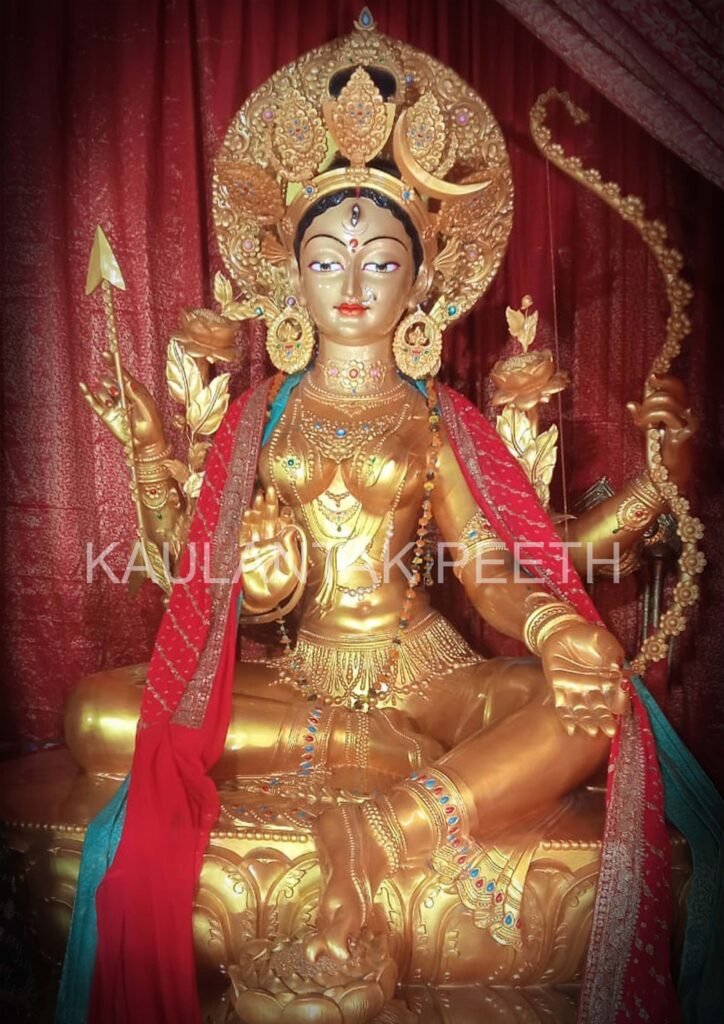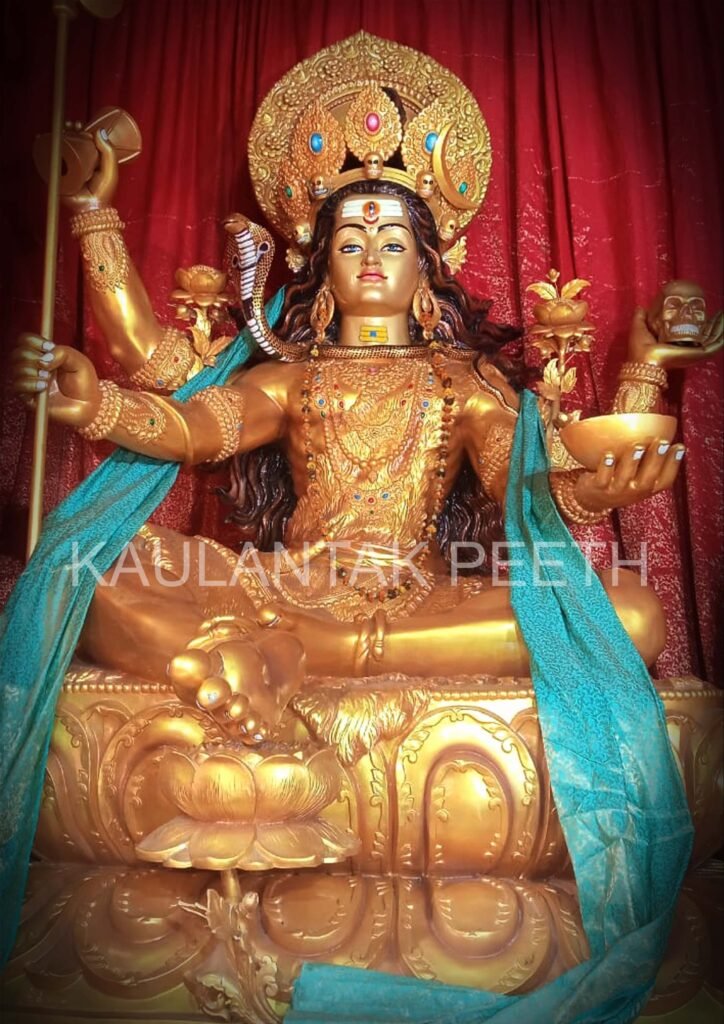Rakta Vartali Devi (Sanskrit: रक्त वार्ताली), as per ‘Siddha Dharma’ is one of the four forms of goddess Vartali with Peet Vartali, Neel Vartali and Shyama Vartali. This form is also known as the maroon form of the goddess. As per ‘Siddha Dharma’, her original form is the rakta/maroon form. Normally when Vartali goddess is depicted in pictures or in any text and yantras, she is depicted in maroon form.
The ‘Siddha Dharma’ regards this form very highly and prescribes her sadhana to the ‘Siddhas’ of the Kaulantak Peeth tradition. She is like an invisible veil that separates a ‘siddha’ from being a ‘mahasiddha’. To become a mahasiddha, one needs to harness the power of mind and heart. It is through the mind that every knowledge and wisdom form in this world is contemplated and pursued. She encourages and guides sadhaka to perfect her to perfect all the wisdoms as prescribed by the ‘Siddha Dharma’ and transform oneself from ‘siddha’ to ‘mahasiddha’.
Etymology
Etymologically, the word Rakt Vartali is a Sanskrit word (रक्त वार्ताली = रक्त + वार्ताली), which translated signifies the combination of the two words Rakt and Vartali (रक्त + वार्ताली) which means ‘Maroon’ and ‘Vartali. So, ‘Rakta Vartali’ is the maroon form of Vartali goddess.
As per ‘Siddha Dharma’, the ‘Rakt Vartali” goddess is the tantric representation of rajas guna in a sadhaka. Rakta means blood and the color of blood is maroon. Blood signifies the inner passion of any person. When our blood flows, so does our mind and intellect. Just like the river in the Himalaya flows down to the society and in the process gets evaporated, condensed and then falls down as the form of rain which is a very cyclic process, similarly is with the blood. The blood flows from the brain to the different parts of the body and then through heart, it again reaches the brain and it is also cyclic. Just like the water is best and pure when it isn’t stagnant similarly the blood is impure if it doesn’t reach the heart and is not filled with oxygen. The lungs provide the body with oxygen and the oxygen is transported to every parts of the body through blood. Blood is life; blood is the source of all passion. Similar is the Vartali goddess. She provides the oxygen for the brain in the form of feelings and thoughts and in the process of strengthening the billions of brain cells keeping the brain very progressive.
The ‘Siddha Dharma’ believes that the “Rakt Vartali” is the goddess of mind and heart, therefore the goddess of both thoughts and feelings. In short, she is the goddess of both left and right brain. The left part of the brain is the ‘logo’ part of the brain which deals with the ‘thoughts’ while as the right brain is the ‘mytho’ part, which represents the bigger frame like image, feelings and emotions. If she is pleased, she can activate the both hemisphere of the brain and transform a person to a philosopher and well as a great poet and artist.
As per ‘Siddha Dharma’, she is the goddess that one should never cease to worship and perfect. But her sadhana is not so easily accessible and available. A person should find a worthy guru, prove his/her eligibility and then get oneself initiated.
Iconography
The ‘Siddha Dharma’ depicts her as the main form among the four forms of Vartali goddess. Being a tantric deity, she is richly depicted in symbols and colors. She is depicted as sitting in padmasana on a lotus flower, she is depicted as maroon complexion, beautiful and is also smiling with her lips not joined and little where her teeth lining can be seen. She is depicted in calm demeanor which means she can be worshiped by householder and ascetic, old age people and children.
The ‘Siddha Dharma’ also depicts her with two big round breasts which don’t signify lust but motherly affection. When she is pleased, she treats her worshipper like her own children and protects them. Her whole body is adorned with ornaments made of gold. She wears a big golden crown on her head and in its centre is the green jem. She also is depicted wearing a big heavy necklace and a big golden garland. She also wears golden bangles in both her wrist.
She is depicted as having four hands. She holds lotus flower in one hand which signifies abundance and prosperity while as in the another hand she is depicted as per ‘Siddha Dharma’ holding a rosary which signifies her in the constant state of sadhana. She is depicted with ‘var mudra’ or ‘boon giving hand gesture’ which means she fulfills the wishes of her worshipper and also bestows boons. Her hand also holds a bow which signifies her to be ‘warrior goddess’ and she can strike anyone with her power and prowess and subjugate them. She also wears a ‘snake bangles’ in biceps of her both hand which means she has full control over her nadi tantra or nervous system and like every other forms she also is depicted with a third eye too.
The Kaulantak Peeth has her own depiction and as per its own guru/sishya lineage. No images of Vartali is in public domain to the best of the knowledge of ‘Siddha Dharma’.
Modes of Worship
The Kaulantak Peeth tradition and the ‘Siddha Dharma’ primarily believe in the guru/sishya lineage because this helps to keep the knowledge free of any fallacies or arbitration. Since, the knowledge of goddess Vartali has passed down many generations from Lord Shiva to His Holiness, the ‘Siddha Dharma’ believes that to protect the sanctity of the sadhana, only guru/sishya lineage prescribed methods should be adopted and other methods be shunned.
The ‘Siddha Dharma’ prescribes many methods of her sadhana and worship methods from Yoga to pure Tantra. She is primarily a tantric deity, so the Peeth mainly prescribes the tantric methods but the Peeth is also eligible to impart it through the mode of Yoga because His Holiness Kaulantak Peethadhishwara “Mahayogi Satyendra Nath Ji Maharaj” (Ishaputra) is also adept in Yoga.
As mentioned before, Vartali goddess is the goddess of flowers. She loves flowers. She is very pleased by flowers. As per ‘Siddha Dharma’ the tantric pleases her through the offerings of various flowers. Her sadhana is to be done in solitude or in the midst of nature.
Besides that, the ‘Siddha Dharma’ can initiate a sadhaka into the sadhana path of Rakt Vartali from the below given methods and procedures. The decision shall rest upon His Holiness Kaulantak Peethadhishwara “Mahayogi Satyendra Nath Ji Maharaj” (Ishaputra) to initiate and impart the teachings to any sadhaka based on his own discretion. The methods and procedures are:
- Kaulachara
- Vedachara
- Mrikulachara
- Tantrokta
- Akulachara
- Mishrachara
- Sastrokta
- Aghorachara
- Vamachara
- Chinachara
- Samayachara
- Yoga Parampara
‘Siddha Dharma’ can also initiate the sadhaka through Yoga procedures. The Yoga procedure is all about using dharana/visualization to achieve the required perfection. The dharana procedure is only given through guru/sishya tradition and cannot be revealed in public as it is against the norms of the ‘Siddha Dharma’
Yantra
Yantra is the physical representation of any deity in geometrical form. The ‘Siddha Dharma’ uses geometric diagrams, words, syllable, symbols to manipulate the consciousness, so as it can be directed in a certain way to create an idea in the mind. Without Yantra, the tantric ritual of Rakt Vartali goddess is impossible. Yantra is the most important part of any tantric ritual.
As per ‘Siddha Dharma’, the ‘Rakta Vartali’ yantra uses triangles, circles and bhupura to create the Yantra.
Mantra
The ‘Kaulantak Peeth’ tradition of the siddha’s has numerous mantras of the goddess. The mantras of the goddess are also as per the modes of their worship. The mantra of Aghorachara is different than Misracharya, Kaulacharya with Akulacharya etc. Furthermore, the Peeth also recommends ‘Shabar Mantra’ for the sadhana procedure as it is very easy to comprehend and is understandable.
There might be lot of schools or modes of worship of the goddess but the Peeth and ‘Siddha Dharma’ prescribes four mantras for each deity for each mode of worship or kulas. For instance, a Aghora panth will prescribe four mantras for the “Rakt Vartali”. The four mantras represent four modes of nature. The four modes of nature or the gunas according to which the mantras corresponds are satwa, raja, tama and nirguna. The Peeth while imparting the diksha and mantra gives four mantras of a deity which is the satwa, raja, tama and nirguna mantra.
Scripture, Texts and eligibility
The Peeth and the ‘Siddha Dharma’ tradition have a special book called “Vartali devi sutram” which is maintained as in the form of oral tradition. The Guru gives the knowledge of the book through oral tradition.
“Vartali Devi Sutram” prescribes methods and percepts that one can cultivate in the daily habits of any individual so as to develop oneself. It prescribes short methods and standards to follow. It also mentions the fact that “Rakta Vartali” is the goddess of calm demeanor, so everyone is eligible to participate in her sadhana.
The Kaulantak Peeth is the Peeth of “veer bhava”, the ‘hero mentality”. So the goddess doesn’t believe in shortcuts. The ‘Siddha Dharma’ believes that to perfect her, strict discipline and perseverance is the key. When she is perfected, it is believed nothing lefts to be perfected.



